bay bridge
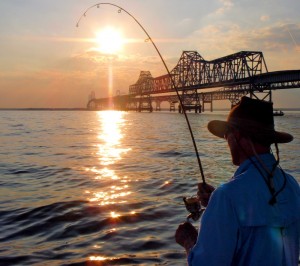 Mmm, July on Kent Island: when the water is savory and smooth and salted with all manner of boats, when tourists flock to the Eastern Shore beaches and bridge traffic backs up for miles while drivers peek over the rail for a glimpse of the sparkling spectacle that is summertime on the Chesapeake Bay. Summer can be both sweet and sour to Chesapeake fishermen. Sometimes we wonder if it’s worth trying to fish in this Hell’s Kitchen of boats, everyone jockeying for the single best position from which to make the sweetest cast. But fish we must, so we line up like line cooks to join the fray, vowing to stay even-tempered when inevitable conflicts arise and deluding ourselves that, when we get there, we’ll have that delicious “top-secret” spot all to ourselves. Mmm, mmm, summertime, sweet summertime. Read More!
Mmm, July on Kent Island: when the water is savory and smooth and salted with all manner of boats, when tourists flock to the Eastern Shore beaches and bridge traffic backs up for miles while drivers peek over the rail for a glimpse of the sparkling spectacle that is summertime on the Chesapeake Bay. Summer can be both sweet and sour to Chesapeake fishermen. Sometimes we wonder if it’s worth trying to fish in this Hell’s Kitchen of boats, everyone jockeying for the single best position from which to make the sweetest cast. But fish we must, so we line up like line cooks to join the fray, vowing to stay even-tempered when inevitable conflicts arise and deluding ourselves that, when we get there, we’ll have that delicious “top-secret” spot all to ourselves. Mmm, mmm, summertime, sweet summertime. Read More!
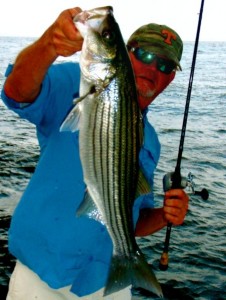 Okay, so this entry might be a little heavy on the fireworks and light on the rockfish. That’s because I’m not too good at fishing in crowds, so I spent most of last weekend doing chores around the house. That’s not to say I didn’t get some time in on the water. In fact, I don’t think I missed a day, but most of my time on Thunder Road was spent cruising to fireworks shows around Kent Island. Since this is a fishing website, I’ll start with a catching report. I met Rich at Sandy Point State Park Friday afternoon for a few minutes of piling picking onboard his 19′ Sea Hunt center console. There was very little wind but plenty of boat wakes, so we took our time getting to the our fishing spots. We had a ripping outgoing current so we rigged up soft plastic lures on three-quarter ounce jig heads. I was throwing a hotrodded white 6″ BKD and Rich had on some kind of chartreuse lure I didn’t recognize. I think we caught keeper size stripers on our first four casts, so we could have had a 5-minute limit. We stayed with it for two and a half hours and released 27 keepers with plenty of shorts. We caught on both the east and west sides of the bridge, even sneaking in downstream of some bored-looking live-liners who didn’t seem to share our amusement when we pulled nice fish right out from under the pilings where they were anchored. Read More!
Okay, so this entry might be a little heavy on the fireworks and light on the rockfish. That’s because I’m not too good at fishing in crowds, so I spent most of last weekend doing chores around the house. That’s not to say I didn’t get some time in on the water. In fact, I don’t think I missed a day, but most of my time on Thunder Road was spent cruising to fireworks shows around Kent Island. Since this is a fishing website, I’ll start with a catching report. I met Rich at Sandy Point State Park Friday afternoon for a few minutes of piling picking onboard his 19′ Sea Hunt center console. There was very little wind but plenty of boat wakes, so we took our time getting to the our fishing spots. We had a ripping outgoing current so we rigged up soft plastic lures on three-quarter ounce jig heads. I was throwing a hotrodded white 6″ BKD and Rich had on some kind of chartreuse lure I didn’t recognize. I think we caught keeper size stripers on our first four casts, so we could have had a 5-minute limit. We stayed with it for two and a half hours and released 27 keepers with plenty of shorts. We caught on both the east and west sides of the bridge, even sneaking in downstream of some bored-looking live-liners who didn’t seem to share our amusement when we pulled nice fish right out from under the pilings where they were anchored. Read More!
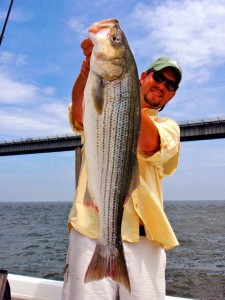 Have you heard? Light tackle casting is producing big fish lately on the Chesapeake Bay. Some lucky anglers are catching fish over 30-inches on almost every trip. Sometimes they get three or four. Most of the fish I’m catching are coming off cover like rocks or bridge pilings, but some have been hooked while fishing submerged structure in open water. Both soft plastics and metal jigs are producing. If you’ve been out, I hope you’re enjoying some lucky days. 30-inch plus stripers in late June is something to celebrate, especially considering how tough fishing has been previously.
Have you heard? Light tackle casting is producing big fish lately on the Chesapeake Bay. Some lucky anglers are catching fish over 30-inches on almost every trip. Sometimes they get three or four. Most of the fish I’m catching are coming off cover like rocks or bridge pilings, but some have been hooked while fishing submerged structure in open water. Both soft plastics and metal jigs are producing. If you’ve been out, I hope you’re enjoying some lucky days. 30-inch plus stripers in late June is something to celebrate, especially considering how tough fishing has been previously.
In my opinion, seasoned anglers make a lot of their own luck. Since the fish are more inclined to bite now, I thought it might be worthwhile to discuss tips for hooking and landing bigger fish – just some little things that can move fishermen up from the usual summer schoolies to true summer trophies. You probably have a few tips as well, so feel free to share them in the comments section. I’ll start with the basics: Read More!
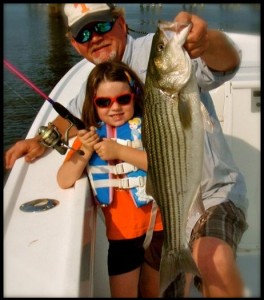 I recently found some old pictures of myself in diapers, standing beside a small wooden boat parked in front of a Tennessee farmhouse. Towering above me was my father, and at my bare feet was a nice stringer of fat largemouth bass. Did I catch them? Probably not, but like any good fisherman, I’ll happily take the credit. I might even tell you a tall tale about how – at the ripe old age of two – I tricked them into biting a lure that I hand carved from a boar’s tusk with a Bowie knife, and how they pulled harder than a Smoky Mountain mule.
I recently found some old pictures of myself in diapers, standing beside a small wooden boat parked in front of a Tennessee farmhouse. Towering above me was my father, and at my bare feet was a nice stringer of fat largemouth bass. Did I catch them? Probably not, but like any good fisherman, I’ll happily take the credit. I might even tell you a tall tale about how – at the ripe old age of two – I tricked them into biting a lure that I hand carved from a boar’s tusk with a Bowie knife, and how they pulled harder than a Smoky Mountain mule.
There’s no doubt that I owe much of what I know about fishing to my father. There’s nothing better than fishing with family. All three of my sons have become first-class fishermen. This week I’ve been fishing with my family’s next generation of anglers. I’ve had a great time on the water with my son Daniel and my granddaughter Ella. I’m happy to report that Chesapeake Bay salinity levels are finally climbing back toward normal levels (see chart below), although they’re still low. Since conditions are stablizing, striped bass fishing is getting a little more reliable. That isn’t to say some days aren’t better than others, but we’re at the point where I at least think we can count on a few fish on any given outing.
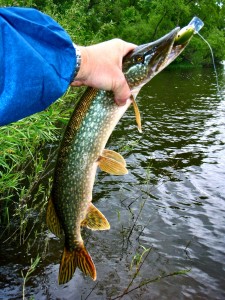 I’ve been off the Bay for well over a week due to some work commitments that took me north to Minneapolis, Minnesota. When this destination was first announced, some of my colleagues were disappointed because of the location. Not me. There aren’t many places I’d rather be because I know how much fun June fishing can be in that part of the country. My first stop was the Minnesota Fishing Museum. It’s located north of St. Cloud in the small town of Little Falls on the Mississippi River. That’s about a hundred miles north of Minneapolis. I’m a big fan of vintage fishing equipment so I had high hopes for the museum. I wasn’t dissapointed. You name it, they had it – everything from antique minnow buckets to classic lures to vintage outboards with even a few old fishing-themed whiskey bottles in the mix. Before we left I asked some ladies at the front desk if there was anyplace close where I could fish the Mississippi River. They told me that most people fished the lakes, but there was a place I could try not too far away.
I’ve been off the Bay for well over a week due to some work commitments that took me north to Minneapolis, Minnesota. When this destination was first announced, some of my colleagues were disappointed because of the location. Not me. There aren’t many places I’d rather be because I know how much fun June fishing can be in that part of the country. My first stop was the Minnesota Fishing Museum. It’s located north of St. Cloud in the small town of Little Falls on the Mississippi River. That’s about a hundred miles north of Minneapolis. I’m a big fan of vintage fishing equipment so I had high hopes for the museum. I wasn’t dissapointed. You name it, they had it – everything from antique minnow buckets to classic lures to vintage outboards with even a few old fishing-themed whiskey bottles in the mix. Before we left I asked some ladies at the front desk if there was anyplace close where I could fish the Mississippi River. They told me that most people fished the lakes, but there was a place I could try not too far away.
I’ll let the video tell the story, but suffice it to say the fishing was good at Blanchard Dam. I’ve heard a lot of good stories about the Mississippi this far north, but never tried fishing here. Every strike brought a different species and I even managed to make some new friends. I even got in some rock hunting, another favorite pastime. “Cross rocks,” they call them. Staurolites that look like Maltese crosses, there are only two other places in the world where they can be found. I never would’ve known except for a fellow I met named Ringwelski. I hit it off with him right away. While it took me ten or fifteen minutes to find a single stone, he could pick them up in a matter of seconds. We fished together two evenings. He told me he owned a farm a few miles up river. Besides being a good rock hunter, he was an excellent fisherman. Read More!
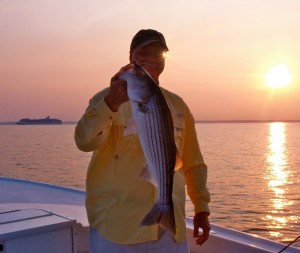 Channel catfish at Hackett’s Bar, carp at the Bay Bridge, snakeheads in St. Jerome’s Creek, and very few stripers in their usual haunts around Kent Island – what’s up with all this late-spring craziness in the Chesapeake Bay? Most fishermen are blaming salt, or more specifically, a lack thereof. Very wet weather in the Susquehanna River watershed has meant lots of fresh water entering the Bay. It’s highly unusual for the Bay to be this fresh in June. Some stations are reporting the lowest readings in recorded history. Salinity is expressed in parts per thousand (ppt), in other words, the number of grams of dissolved salts present in 1,000 grams of water. The water in the Atlantic Ocean is about 35 ppt. Surface salinity today at the Gooses Reef Buoy in the Mid-Chesapeake Bay is 2.0 ppt. That’s low! For better striped bass fishing, we need more salt.
Channel catfish at Hackett’s Bar, carp at the Bay Bridge, snakeheads in St. Jerome’s Creek, and very few stripers in their usual haunts around Kent Island – what’s up with all this late-spring craziness in the Chesapeake Bay? Most fishermen are blaming salt, or more specifically, a lack thereof. Very wet weather in the Susquehanna River watershed has meant lots of fresh water entering the Bay. It’s highly unusual for the Bay to be this fresh in June. Some stations are reporting the lowest readings in recorded history. Salinity is expressed in parts per thousand (ppt), in other words, the number of grams of dissolved salts present in 1,000 grams of water. The water in the Atlantic Ocean is about 35 ppt. Surface salinity today at the Gooses Reef Buoy in the Mid-Chesapeake Bay is 2.0 ppt. That’s low! For better striped bass fishing, we need more salt.
Fishermen have long recognized the importance of locating comfort zones where fish prefer to stay, but sometimes that isn’t so easy. Fishing in late May and early June is usually a challenge, but low salinity levels have made it especially difficult this year. Complicating the matter is that he water can be a lot saltier on the bottom of the Bay than it is on top this time of year. Since, in addition to surface observations, The Gooses Reef Buoy also provides salinity readings from the bottom of the Bay, we can see that it’s currently 7.1 ppt. That’s over three times saltier than it is on the surface. Read More!


